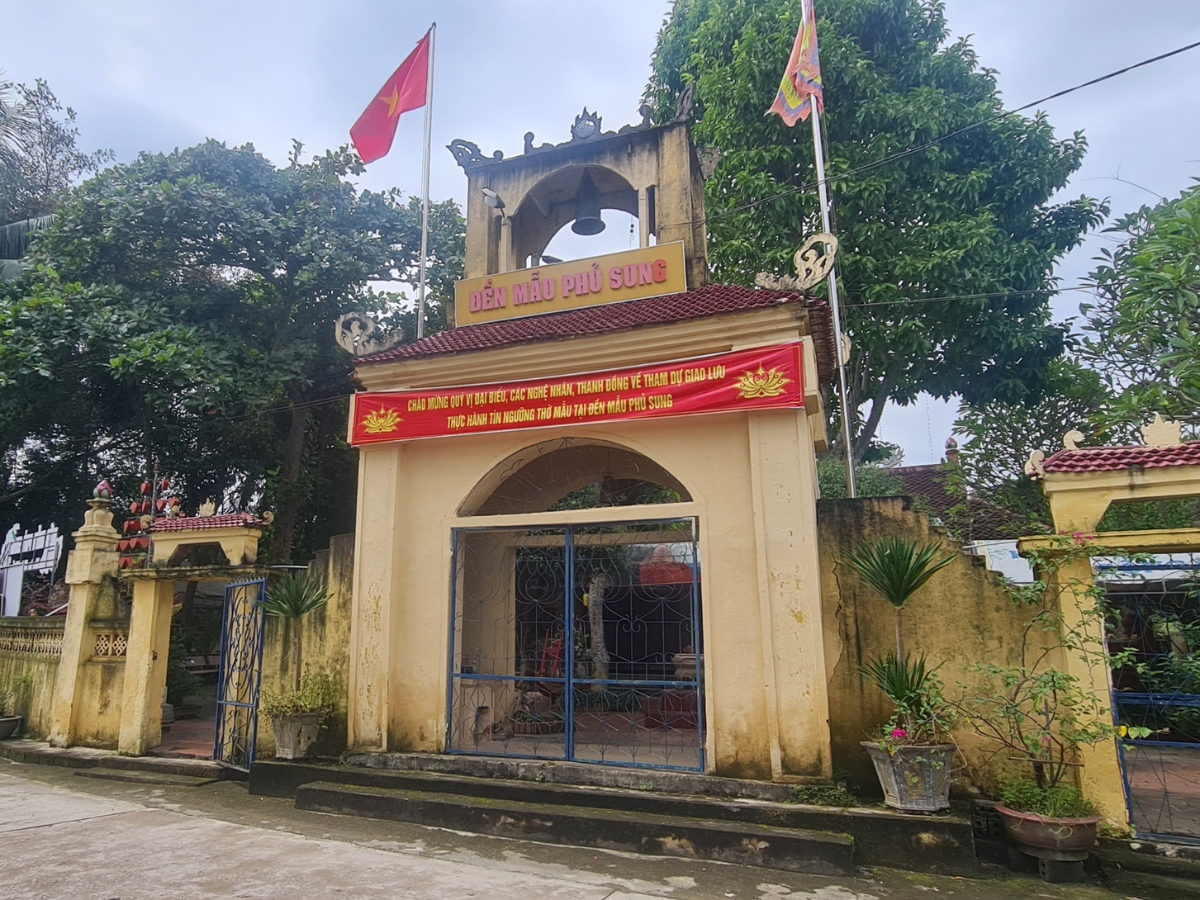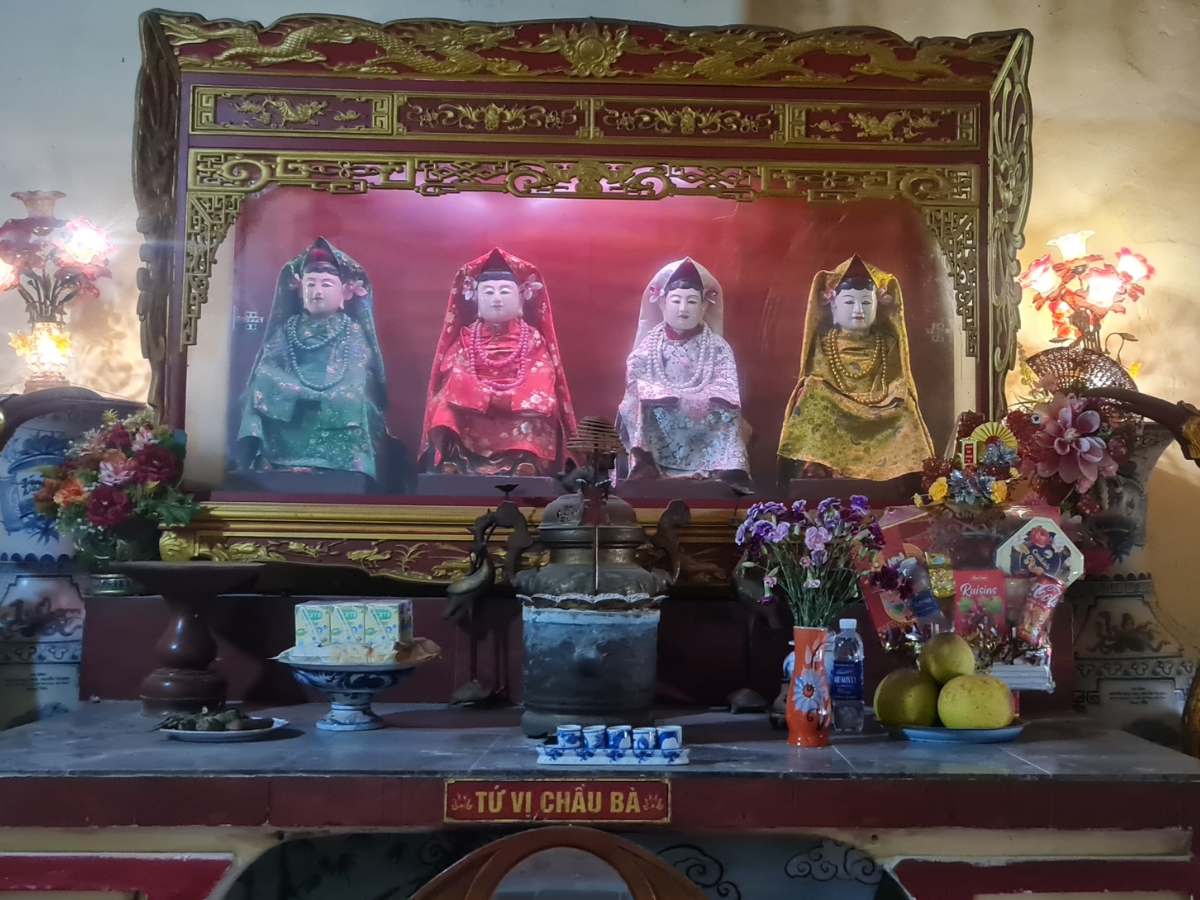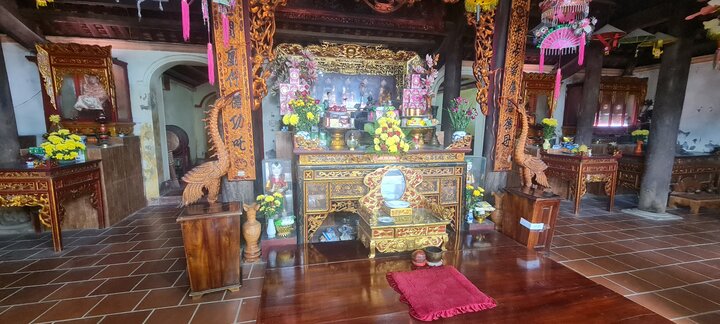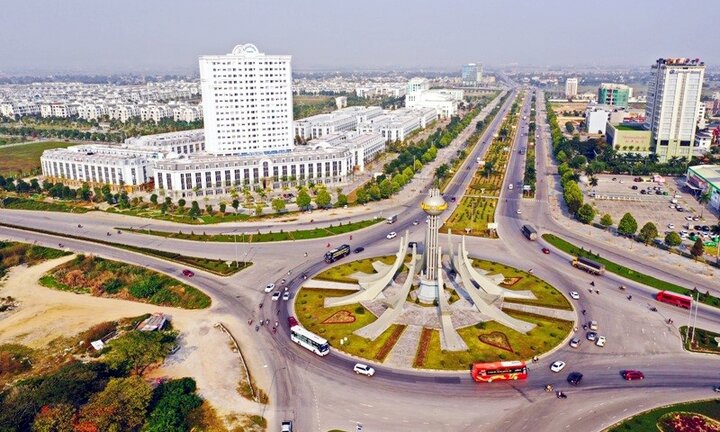1. About Phu Sung
1.1. Where is Phu Sung?
Phu Sung is located in Nhu Thanh commune, Thanh Hoa province. This is a peaceful region nestled amidst dense mountains and forests, a place where nature and folk beliefs converge. According to historical records, Phu Sung is a historical and cultural relic and an architectural art site dedicated to Mother Goddess worship, where Saint Mother Lieu Hanh is revered as the foremost deity in the pantheon.

Phu Sung is one of the famous Mother Goddess worship sites in Thanh Hoa. (Source: Collected)
1.2. History of formation and development
According to historical records, Phu Sung is a historical cultural relic and architectural art of Mother Goddess worship, in which Thanh Mau Lieu Hanh is revered as the supreme deity in the pantheon. Legend has it that Thanh Mau Lieu Hanh was originally the daughter of Ngoc Hoang Thuong De, who was banished to the mortal world for committing a mistake, reincarnated into the Le family and was named Giang Tien. After marrying and having children, she was summoned back to heaven, but out of longing for her husband and children, she asked to return to the human realm. In subsequent descents, the immortal princess traveled everywhere, helping people eliminate disasters, teaching them to do good deeds, and creating many sacred legends.
On her third descent, Thanh Mau Lieu Hanh, along with two maids, came to the Pho Cat region, now part of Thanh Hoa. Here, she punished the wicked, helped the good, and brought peace to the people. This incident led the court to misunderstand her as a demon and send troops to eliminate her. The battle between Tien Quan Thanh and the Immortal Princess took place fiercely at Nui Song mountain, also known to the world as the Sung Son great battle.
After Buddha manifested to mediate, the king bestowed upon her the title Ma Hoang Cong Chua, and later Che Thang Dai Vuong – symbolizing benevolence, compassion, and the power to save sentient beings. From then on, Thanh Mau Lieu Hanh was revered as one of the “Four Immortals” of Vietnamese folk culture, and Phu Sung in Nhu Thanh was erected as the most sacred Mother Goddess worship center in the Thanh region for pilgrims from all directions to visit, worship, and pray for peace every early spring.
1.3. Famous Mother Goddess worship sites in Thanh Hoa
Within the system of typical Mother Goddess worship centers of the Thanh region, Phu Sung is considered one of the most sacred destinations, along with Song Son temple, Phu Na, Phu Tro, and Chin Gieng temple. These are all places where Thanh Mau Lieu Hanh is worshipped, the Saint among the Four Immortals of Vietnamese folk belief, a symbol of benevolence, sacrifice, and the power to protect all people.
Through many centuries, these relics have not only been sacred pilgrimage sites but also centers of unique cultural and religious activities, deeply connected to the spiritual lives of the local people. Every year, during festivals, tens of thousands of pilgrims from all directions flock to Phu Sung, Song Son temple, or Phu Na to offer incense, pray for peace and blessings. These places have contributed to the identity of Mother Goddess worship in the Thanh region, affirming the enduring vitality of Vietnamese folk culture through the ages.
2. Architectural characteristics, space, and cultural values of Phu Sung
The architecture of Phu Sung is deeply traditional, clearly expressed through exquisite carved details, gracefully curved temple roofs, and a solemn worship space. Surrounding the temple is a serene natural landscape, with trees providing shade, birdsong mingling with the gentle chime of wind bells, all creating a peaceful space, ideal for those seeking tranquility to worship and find peace of mind.

A peaceful and serene space at Phu Sung. (Source: Collected)
From outside to inside, Phu Sung is arranged in a traditional architectural style. The outermost part is an ancient nghi môn (gate), followed by a temple courtyard of about 210 square meters, enclosed on three sides by sturdy brick walls. The main hall consists of 5 bays, 4 roof trusses, with two tiled roofs, built using traditional composite materials. Inside, the worship system is arranged in the central bay, with an altar divided into three tiers. The highest tier is the altar for the Mother Goddess, the middle tier holds incense bowls, a pair of lamps, and bronze incense burners, and the lowest tier has an incense bowl with two bronze incense holders, reflecting the solemnity and reverence in the worship rituals.
Notably, Phu Sung currently still preserves many ancient artifacts of high historical and artistic value such as a round bronze incense burner from the Nguyen Dynasty, a pair of bronze incense holders, stone dogs guarding the front yard, twelve stone slabs, and a pair of ancient couplets inscribed with Han characters hanging in the central bay. These ancient objects not only possess aesthetic value but also serve as evidence of the tradition of ancestor veneration and the heritage preservation consciousness of the people of Nhu Thanh. The entire structure is a crystallization of folk art, Mother Goddess worship, and Vietnamese spirituality, making Phu Sung a sacred yet familiar relic, fully preserving the cultural essence of Thanh Hoa.

Area of the Temple of the Four Goddesses at Phu Sung. (Source: Collected)
3. Traditional rituals and religious activities at Phu Sung
At Phu Sung, religious activities take place year-round, deeply imbued with the spiritual culture of the people of Thanh Hoa. This is a place where visitors come to offer incense, pray for blessings, and seek peace for their families, work, and health. The rituals are performed solemnly, showing reverence for Saint Mother Lieu Hanh.
On every occasion of early spring, the full moon of the first lunar month, or the Saint Mother's veneration days, the space of Phu Sung becomes sacred with fragrant incense smoke rising densely, the sound of bells and drums echoing, blending with sincere prayers. Visitors often prepare offerings to present, entrusting their wishes for a peaceful new year, favorable weather, and a prosperous life.
Furthermore, many people also perform rituals such as asking for the Saint's blessings, writing petitions for peace, drawing fortune sticks at the beginning of the year, praying for love, and praying for wealth. These rituals not only carry spiritual significance but also serve as a way for people to cultivate goodness, live kindly, and cherish traditional spiritual values. With a tranquil, solemn atmosphere steeped in faith, Phu Sung becomes a spiritual anchor for everyone, a place to calm one's mind and find peace amidst a busy life.
4. Guide to traveling to Phu Sung 2025
Traveling from Hanoi to Phu Sung:
From Hanoi, visitors can choose various means of transport to reach Phu Sung, such as private cars, coaches, or motorbikes. The distance is about 170 - 190 km, with an average travel time of 3.5 to 4 hours. The most convenient route is via the Hanoi – Ninh Binh expressway, then turn onto National Highway 45 towards Nhu Thanh commune to reach the relic site. The road is quite easy to travel, and the scenery along the route consists of fields, mountain ranges, and peaceful countryside, bringing a sense of relaxation to visitors throughout the journey.
Traveling from Ho Chi Minh City and southern provinces:
From Ho Chi Minh City and the southern provinces, visitors can fly to Tho Xuan Airport (Thanh Hoa), then continue traveling by taxi or ride-hailing service to Phu Sung. The distance from the airport to Phu Sung is about 40 km, with a travel time of about 1 hour. Alternatively, visitors can choose to take a train to Thanh Hoa Station, then take a bus or taxi to Nhu Thanh commune. This is a convenient combined route, suitable for both pilgrims and day-trippers.

Tourists from southern provinces can travel by plane to Phu Sung. (Source: Collected)
Thanh Hoa Province's Internal Transportation:
For tourists departing from Thanh Hoa city, reaching Phu Sung is quite easy with many options such as inter-provincial buses on the Thanh Hoa – Nhu Thanh route, buses, or taxis. Internal provincial routes have been upgraded and expanded, ensuring convenient travel. Tourists traveling in groups or families can rent private cars to be more proactive about their time, while also combining visits to other prominent spiritual destinations.
5. Tips for Phu Sung Pilgrimage
Suggestions for preparing offerings, attire, and rituals to know:
When making a pilgrimage to Phu Sung, tourists should prepare simple but sincere offerings. Offerings usually include incense, fresh flowers, betel leaves and areca nuts, oản, sticky rice, fruits, and sometimes banh chung or sweet soup to offer to the Holy Mother. In the sacred space, visitors need to dress neatly and politely, avoiding revealing, short, or offensive attire. When performing rituals, maintain a solemn attitude, offer incense gently, do not push or talk loudly. Thanh Hoa people particularly value sincerity, so the most important thing is not a full offering tray but the good intentions of the worshipper.

Prepare sincere offerings when visiting Phu Sung. (Source: Collected)
Photography tips and exploring the beautiful scenery around Phu Sung:
Not only a sacred place, Phu Sung also boasts a peaceful, poetic landscape with ancient trees, moss-covered tiled roofs, and winding stone paths. The ideal time for photography is early morning or late afternoon when the sunlight is gentle and mist still lingers on the temple roofs. Visitors can capture beautiful moments by the lake, the temple courtyard, or in front of the ancient gate, where light and incense smoke blend to create a mystical picture. When taking photos, it is advisable to respect the sacred space, avoid standing too close to the altar, or using flash in the main hall.
Suggested itinerary for exploring the spiritual land of Thanh Hoa:
After offering incense at Phu Sung, visitors can combine visits to other famous spiritual destinations in Thanh Hoa such as Song Son Temple, Phu Na, Xuan Pha Shrine, and Ham Rong Bridge. Additionally, Sam Son beach square is an ideal stop for a stroll, enjoying the sea air, and participating in recreational activities. Furthermore, the Huyen Tich Am Tien project at Nui Nua is currently under construction, promising to become a unique spiritual tourism center in the future. This combined itinerary will not only help visitors gain a deeper understanding of Mother Goddess worship but also appreciate the diverse, simple, and vibrant beauty of the Thanh Hoa region.

Huyen Tich Am Tien promises to be an impressive spiritual tourism destination in Thanh Hoa. (Source: Thanh Nien Newspaper)
The journey to Phu Sung is not just a pilgrimage to the Holy Mother, but also an opportunity for visitors to immerse themselves in the serene spiritual space amidst the Thanh Hoa mountains and forests. With its ancient, sacred beauty and deep connection to the spiritual life of the people, Phu Sung deserves to be the foremost pilgrimage destination for those who wish to find a place of peace, and fully experience Vietnamese cultural and spiritual values. If you have the chance to visit Thanh Hoa, take the time to explore Phu Sung to feel the sacred space amidst the mountains and forests, listen to the breath of heaven and earth, and rediscover peace in your soul.







